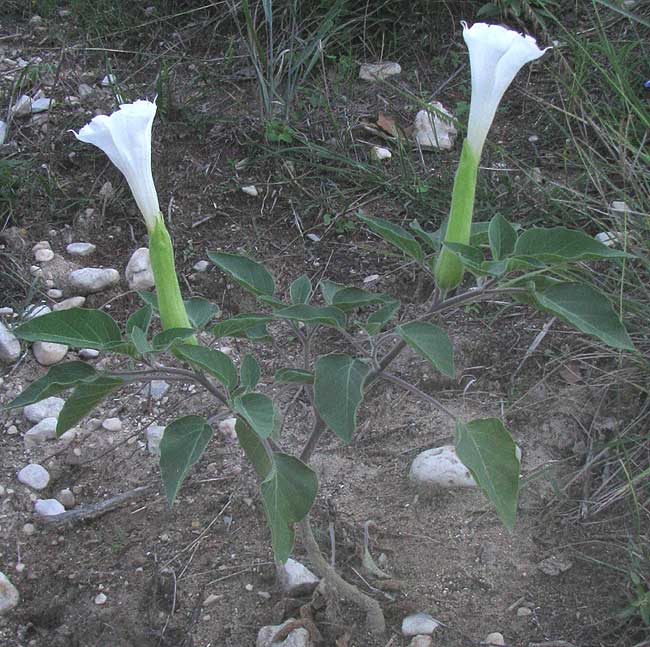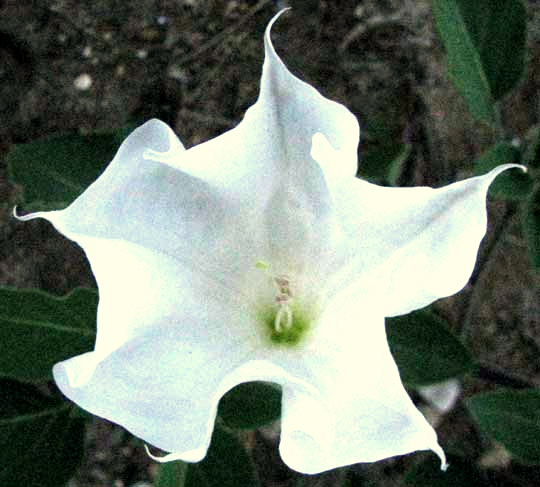Excerpts from Jim Conrad's
Naturalist Newsletter

from the the October 7, 2012 Newsletter issued from the valley of the Dry Frio River in northern Uvalde County, southwestern Texas, on the southern border of the Edwards Plateau; elevation ~1750m (~5750 ft); N29.62°, W99.86°; USA
THORN APPLE/ MOONFLOWER
When at dusk it gets so dark you start tripping over things, nowadays certain small glowings show up low on the landscape. If you're not seeing the white tails of our innumerable White-tailed Deer probably you're seeing the moonlight-gathering flowers of the knee-high plant shown above.
Those flowers are impressive not only for how they show up in the darkness but also for their size, nearly eight inches long (20cm). If you walk up to the plant and look down on a blossom you see a surprisingly elegant esthetic expression, sort of a half-hearted spiraling around a deep center where pale stamens clustered around a pistil can be seen, as shown below:

The flowers open at dusk and stay open all night. After being pollinated by night-flying sphinx moths -- which look and act like small hummingbirds -- the corollas drop off about mid-morning the next day, leaving behind the item shown below:

That's the flower's ovary cradled in its bowl-like calyx. The soft spines covering the ovary will become harder and much larger spines on the fruit, accounting for one of the most frequently used names for the plant, Thorn Apple. It's also called Pricklybur, Moonflower, Jimson Weed, Angel's Trumpet, Devil's Trumpet, Stinkweed, Sacred Datura, and a host of other names. It's DATURA INNOXIA, a member of the Nightshade Family, the Solanaceae.
We've run into Thorn Apple before, in Mexico, where we called it Devil's Weed in remembrance of Carlos Castaneda's books, particularly The Teachings of Don Juan: A Yaqui Way of Knowledge. There's more on that in the "Devil's Weed" entry below.
from the October 28, 2012 Newsletter issued from the valley of the Dry Frio River in northern Uvalde County, southwestern Texas, on the southern border of the Edwards Plateau; elevation ~1750m (~5750 ft); N29.62°, W99.86°; USA
THORN APPLE PRODUCING THORNY APPLES
Nowadays the Thorn Apples are producing their spiny fruits, as shown below:

That fruit is interesting not only because of its prickles but also for its oversized, brown, papery calyx. I'm guessing that the large calyx catches in the wind and shakes the fruit when it is shedding seeds.
I believe that the fruit in the picture has been opened by an animal, probably a bird, to get at the seeds. Thorn Apple fruits open irregularly, not along defined sutures as in most fruits that split upon maturity. However, one clue that this fruit has been irregularly opened by an animal is the seed lying atop the capsule.
from the May 5, 2007 Newsletter issued from issued from Sierra Gorda Biosphere Reserve, QUERÉTARO, MÉXICO
DEVIL'S WEED OUTSIDE MY DOOR
If you're of a certain age you probably read one or all of Carlos Castaneda's books, particularly The Teachings of Don Juan: A Yaqui Way of Knowledge, first published in 1968. The Yaqui people originally lived in the northwestern Mexican state of Sonora and part of Arizona. Don Juan was a brujo, or witchdoctor, who taught the narrator of the book how to refine his awareness of the Universe. It's unclear how much of Castaneda's writings are real or pure fantasy, and also it's unclear whether there was a real Don Juan.
Don Juan used hallucinogens as part of his practice, and one of the most powerful he called Devil's Weed, sometimes also called Toloache. These names can apply to various species of the genus Datura. In English we call the Daturas jimsonweeds. Don Juan's jimsonweed probably was DATURA INOXIA. Five blossoming plants of Datura inoxia grow right outside my door as I type this, right in the center of my field of vision when I look outside, standing there as if they were waiting for me. Right now I go photograph one so you can see.The picture is below:

That glowing, white blossom at the plant's head is 6.5 inches (16.5 cm) high. Surely someone threw seeds there, for I seldom see the plant elsewhere. Each dawn each datura plant bears one or two blossoms, which wilt by late morning. Each dawn, it's like being greeted by five gnomes, half smiling, half malicious- looking, playing white violins, somberly, soporifically.
Folks here regard the plants as young Angel's Trumpets, which are the small trees with very large, white, drooping flowers I introduced in this year's January 19th Newsletter. Angel's Trumpets are members of the same family as Datura inoxia, the Nightshade/ Tomato Family or Solanaceae, and also are poisonous and hallucinogenic, but they are an entirely different species.
Like me, Don Juan had mixed feelings about Devil's Weed:
She is as powerful as the best of allies, but there is something I personally don't like about her. She distorts men. She gives them a taste of power too soon without fortifying their hearts and makes them domineering and unpredictable.
If you Google Datura inoxia you'll find as many warnings about poisoning as you will mention of the plant as hallucinogenic. One reason is that the dosage needed to feel the effects is pretty close to that which poisons, and it's very hard to judge the active ingredients' concentrations in wild plants.
I have instructions on exact preparation of the plant, but I'm not interested in concocting a dosage for the same reason I'm also against drunkenness and being a pot-head: Brains are the only resource we humans have to keep us from blindly destroying Life on Earth. If we screw up our brains, there's less chance we'll survive.